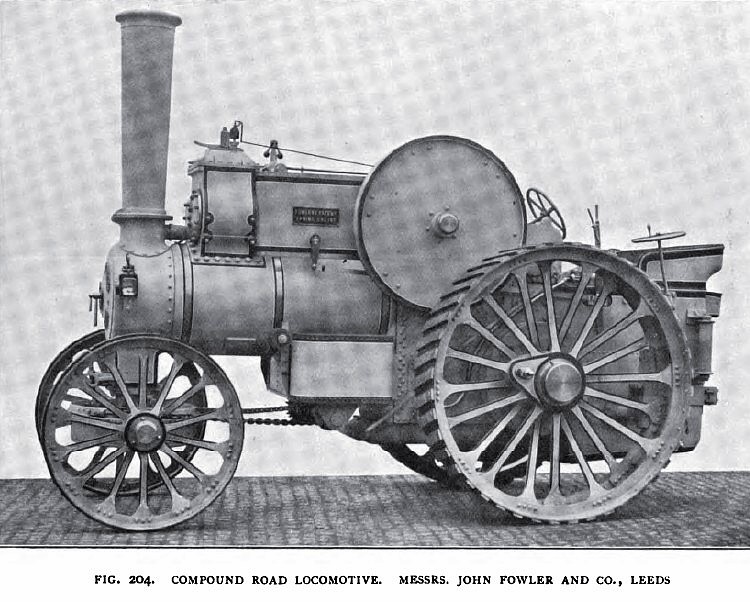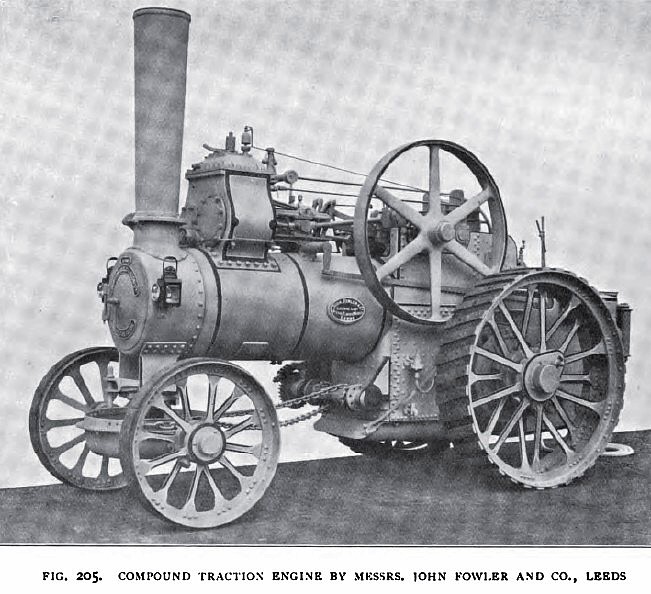|
Title: |
1904 Article-John Fowler & Co., Compound Steam Road Locomotive |
|
Source: |
English and American Steam Carriages and Traction Engines 1904 pg 329 |
|
Insert Date: |
8/17/2011 1:02:27 PM |
MESSRS. JOHN FOWLER AND CO. — The first illustration, Fig. 204, represents a type of road locomotive suitable for pioneer work. A similar one was sent to Uganda. It is a compound engine fitted with a fore tank, an awning, a disc flywheel, and all the equipment for making long journeys without constant stoppages for taking in water, etc. Road locomotives of this type have been shipped to the Colonies. The following is a brief account of work done in Australia. "A load of wool was hauled 40 miles, part of the journey being across country without any road whatever. The engine crossed Lachlan River with banks 50 feet deep, and pulled the load after her with ease; the engine was sent up country 300 miles in a time of drought for irrigating purposes; the pump driven by the engine delivered 2,000 gallons per minute, and was kept running night and day." Fig. 205 represents a compound general-purpose engine. The slide-valves are arranged near the top of the cylinder casing; the valve - rods are set at an angle to point to the centre of the crank-shaft. An auxiliary valve is provided for sending high-pressure steam into the low-pressure valve chest, so that for the time being the engine will work as a double-cylinder non-compound engine. The valve closes automatically when released by the driver. Stauffer's lubricators are used for the front and hind wheel naves. An inside tire is fitted in the driving-wheels; the front wheel spokes are all riveted to the same side of the tee steel ring; instead of being riveted on each side alternately as is usually done, the makers have some good reason for deviating from the general method of construction. A strong draw-back lug is fitted to the fore carriage locking-plate, a circular box is hung to the front axle, the chimney is of extra large diameter. Mud-holes are provided in the corners of the saddle-plate; the horn-plates are double-riveted to the saddle-plate and arch-plate as shown. A cap covers the key end of the flywheel. The engine is provided with a winding-drum and wire rope, a water-lifter, and hose-pipe. During some trials of a 10-horse nominal road locomotive (not illustrated) about 7 cwt. of coal was sufficient for a journey of 30 miles, and 430 gallons of water was carried, a fresh supply of which was required every 12 to 15 miles. The engine hauled 33 tons gross up a continuous rise of 1½ miles, part of which is as steep as 1 in 13. The driving-wheels are 7 ft. diameter and 2 ft. wide on face, fitted with tee-iron cross strips. Three speeds are provided—the slow, 1½to 3 miles an hour; the middle gear gives 2½ to 4½ miles an hour; and the fast gear from 6 to 8 miles an hour. Messrs. Fowler's spring-mounting arrangement has been described in Chapter VII. A large compound engine made by the firm, hauls five heavy vans containing the paraphernalia for a steam circus or roundabout. The engine draws the apparatus during the daytime ; at night it also keeps the machine in full swing, and drives a dynamo for lighting up the whole show. On the road the engine hauls the five vans and water-cart at a good speed up some of the steepest hills in Kent, Surrey, Berks, Bucks, and Oxfordshire. An engine of this type started from Leeds on a journey of 88 miles with a load of 45 tons; the load consisted of 10 wagons of switchback machinery; the time occupied was 28 hours.
A considerable number of road locomotives are used in many districts for hauling huge boilers, machinery, and other commodities that the railways are unable to carry. By the employment of these road trains some traders are practically independent of the railway companies, and the economy of steam haulage is proved beyond doubt. The Engineer recently remarked: "Hitherto the transports for the Dover and Canterbury maneuvers have gone by rail ; they are now being taken by road by traction engines. It is suggested that traders and farmers might adopt the same system by judicious co-operation. Many classes of merchandise would suffer nothing from the longer time spent in conveyance. The military authorities reckon that they are making a saving of fifty per cent." As an instance of the economy secured by the employment of road locomotives, may be mentioned the removal of a large boiler which cost £1 15s. If horses had done the work, this would have cost over £5, occupying a much longer time, and taking up considerably more room. |
|
 1904 John Fowler & Co., Compound Steam Road Locomotive
1904 John Fowler & Co., Compound Steam Road Locomotive
 1904 John Fowler & Co., Compound Steam Traction Engine
1904 John Fowler & Co., Compound Steam Traction Engine
|
|